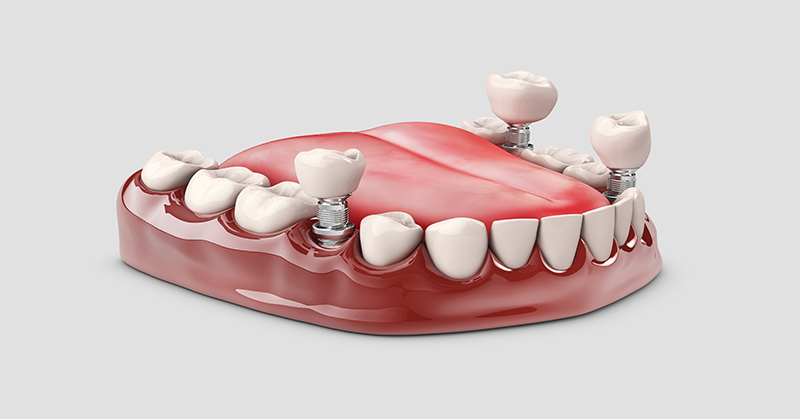How to get free dental implants?
When it comes to dental implants, the cost can sometimes make you clench your teeth harder than the cold does. But fear not! There are a plethora of avenues to explore for low-cost or even free dental care. From state and local resources to dental schools and community health centers, let’s dive into where you can find that much-needed dental implants without breaking the bank.How Painful is Dental Implant Surgery?
updated on November 15, 2023
If you are missing teeth due to decay, injury, or gum disease, dental implants offer an effective and natural-looking replacement option. Unlike removable dentures that can slip, implants fuse securely into your jawbone for permanent stability. They also help preserve bone and support surrounding teeth better than bridges or dentures. But most patients wonder - how painful are implants? The procedure does involve surgery and recovery time.
This article will discuss what to expect from the implant surgical phases, how long healing takes, and aftercare tips for managing discomfort. If you’re considering implants to replace missing teeth, learning about the process will help you know what to anticipate for optimal surgical experiences and post-procedure oral health.
Dental Implant Phases
As a refresher, dental implants are artificial tooth roots made of biocompatible titanium that integrate with the jawbone, topped by porcelain crowns or dentures. The implant surgical process involves multiple phases over several months to fully replace missing teeth.
Phase 1 - Implant Placement
The first phase is placing the titanium implant fixtures into the jawbone. During this initial surgery, the oral surgeon will make a small incision in the gums to expose the bone. Next, a tiny hole is drilled where the implant will be located. The titanium fixture is then screwed or tapped into the bone socket. For multiple missing teeth, several implants may be placed in one appointment.
Once all implants are positioned, the gums are stitched closed. Over the next 4-6 months, the jawbone will fuse to the titanium through natural osseointegration as new bone cells grow around the implant. This creates a strong, permanent hold.
Phase 2 - Abutment Connection
After sufficient healing time, phase two involves making small incisions to re-expose the implants under the healed soft tissue. An abutment is then attached to each implanted fixture. The abutment acts as an extension piece that the final crown will mount onto. It protrudes up through the gums, providing structural support.
Phase 3 - Restoration Placement
The last phase completes the tooth replacement process by attaching permanent or temporary crowns, bridges, or dentures to the abutments. The prosthetic teeth securely screw into the abutments, replacing the missing teeth. After 4-6 weeks of gums healing around the restoration, the final prosthesis is secured in place.
Whether Dental Implant Surgery Is Painful?
It's normal to have some pain and discomfort after getting dental implants placed. The surgical process involves incisions and drilling into the gums and jawbone, so you can expect swelling, soreness, and tenderness initially. However, serious or prolonged pain is not typical and may signal complications.
In the first 1-2 weeks following surgery, common symptoms patients experience include:
-
Mild throbbing or soreness at the implant site as the area heals. Over-the-counter medication can relieve this pain.
-
Some bruising, swelling, or bleeding of the gums around the implant. Using ice packs helps minimize swelling.
-
Numbness of the lips, gums, or teeth near the surgical site due to inflammation pressing on nerves. Feeling should return to normal within a few weeks.
-
Difficulty chewing on the implant side at first. Stick to soft foods during initial healing.
-
Low-grade fever, tiredness, or headaches as the body recovers. These usually pass within a few days.
Severe pain that persists beyond 2 weeks or gets worse again after initially improving may indicate complications. Other concerning symptoms include ongoing bleeding, pus discharge, or a bad taste from the site. Contact your dentist promptly if any worrisome signs arise.
-
Post-Operation Care For Dental Implants
Proper aftercare is crucial for allowing your mouth to heal correctly after dental implant surgery. Following your dentist's recommendations will support the best outcome.
For the first 2 days, wear any provided temporary dentures or bridges continuously, even at night. This prevents swelling from interfering with the fit. Apply ice packs to the outside of your face near the surgery site for 20 minutes on and off for the first 24 hours to minimize swelling.
If you experience any bleeding or oozing, carefully bite down on folded gauze or apply direct pressure to clot it. Avoid heavy bleeding. Stick to a soft, cool diet initially to prevent irritation. After 24 hours, gently rinse with saltwater but don't vigorously swish the surgical areas.
Refrain from strenuous activity for 3-5 days or until swelling and pain subside enough to allow it. Avoid smoking or tobacco use during recovery, as nicotine impedes healing. Take any prescribed medication as directed for pain and infection prevention.
Be diligent about scheduled follow-up appointments so your dentist can monitor healing and remove any stitches if necessary. Report any unusual symptoms like persistent bleeding, severe pain, or bad tastes promptly.
The recovery period is temporary but critical. By closely adhering to post-op guidelines, you allow your mouth the time it needs to properly fuse the implants and rehabilitate the surgery sites. Patience and compliance with aftercare ensures your implants successfully integrate and restore your smile function.

free&low-cost dental clinics
View Now
dental health

Dental Implants

Dental Implants
How Can I Get Government Grants for Dental Implants?
Dental implants are a sought-after solution for missing teeth, offering a long-term fix that can significantly improve quality of life. However, the cost of dental implants can be prohibitive for many. Understanding government programs and other grants available for dental care, particularly dental implants, can help bridge this financial gap. In this guide, we will walk you through some government assistance and grant programs aimed at making dental implants more accessible.
Dental Implants
How to Find Dental Implants for Low Income
Dental implants are popular and effective solutions for replacing missing teeth. However, they can be quite expensive. For instance, one single implant can cost about $1500 in the US.If you're looking for ways to make dental implants more affordable, this article will provide you with five practical strategies to save on cost.
Dental Implants
Top Dental Implant Brands in the United States
When it comes to dental implants, finding a reputable and reliable dental implant service is crucial. Dental implants are a popular and effective solution for replacing missing teeth, providing individuals with improved aesthetics, functionality, and oral health.With the increase in demand for dental implants, numerous brands have emerged, providing a variety of options to meet the diverse needs and budgets of patients. Choosing the right dental implant brand is vital as it directly affects the success and longevity of the dental implant procedure. In this article, we will explore some of the top dental implant brands in the United States, known for their expertise, advanced technology, and exceptional patient care.
Dental Implants
How to Get Your All-On-4 Dental Implants Without Breaking the Bank
In the United States, the cost of All-On-4 dental implants can vary significantly depending on your location. For instance, the cost in different states ranges from around $12,000 to $39,200 per arch. When seeking affordable options domestically, it's important to explore various clinics and compare their pricing. Additionally, some dental practices might offer flexible payment plans or dental loans to help manage the costs.
Dental Implants
What Are the Possible Risk Or Side Effects for Dental Implants?
Dental implants provide an excellent way to replace missing teeth and restore your smile. But as with any medical procedure, there are possible risks and side effects to consider before undergoing implant surgery. In this article, we aim to provide a comprehensive overview of dental implants - what they are, who is a suitable candidate, and most importantly, the potential risks and complications that can arise. By understanding both the benefits and possible downsides of implants, you can make a fully informed decision about whether they are the right choice for your individual needs and health profile.







